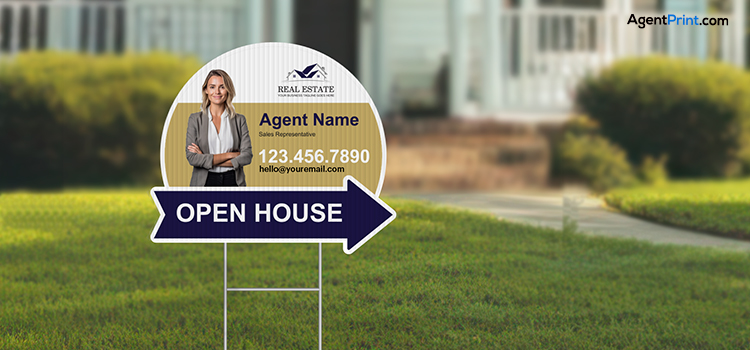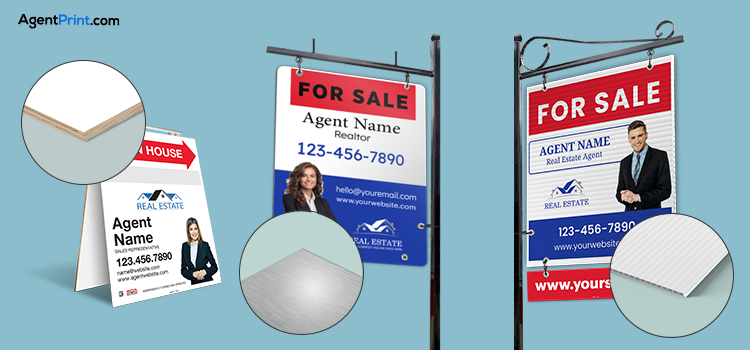In marketing campaigns, real estate signs play a significant role as an important marketing material. Choosing the appropriate materials for outdoor real estate signs, especially in Canada, is essential for successful property marketing. However, sometimes it is challenging to choose your signs, or decide which material to use, or determine what kind of sign will make the best impression.
We are here to answer your questions, so don’t worry. We will read about the most popular real estate sign materials in this blog post and compare their features, prices, and uses. In the end, we hope that this information will make it easier for you to choose the right kind of sign and material to successfully meet your marketing goals.
Read more: Real Estate Sign Rules and Guidelines in Canada (2025 Update)
Most Common Real Estate Sign Materials
When designing a real estate sign, it is critical to consider the target audience, environmental factors, and anticipated duration. Your outdoor signs will effectively promote the property and endure the weather for a long time if you choose the right material. Here, we are going to check the features of the most common real estate sign materials to help you understand the differences.
Coroplast

Real estate signs frequently use coroplast material, which is lightweight, weatherproof, and made of corrugated plastic, mostly polypropylene. You can print on both sides of Coroplast signs for better results. They come in a variety of thicknesses and sizes and are reasonably priced and adaptable.
Vibrant colours and striking graphics can be easily added to them to draw attention and efficiently communicate important information. Because of these qualities, they are perfect for temporary outdoor applications like “For Sale” or “Open House” signs.
Crezon
Because of its high durability, exterior-grade plywood known as Crezon is frequently used for outdoor real estate signs. It is renowned for its flat, smooth surface, which makes it perfect to withstand moisture and tearing. Among its notable features are its high strength-to-weight ratio, waterproof bond, and outdoor suitability.
Real estate signs exposed to the weather can benefit from this material’s special outdoor engineering. The smooth surface of Crezon guarantees the expert-looking signs, with sharp and colourful printing. More importantly, due to their natural wood origin, many Crezon boards are recyclable, which is in line with eco-friendly practices.
Aluminium

Rain, wind, and sunlight are just a few of the severe weather conditions that aluminium can tolerate because of its inherent resistance to rust and corrosion. Aluminium has enough rigidity to hold its shape and not bend or warp, but it is also lightweight, making it simple to handle and install. For printing and applying graphics, text, and images, aluminium offers a smooth, polished surface.
To satisfy particular branding and marketing requirements, aluminium signs can be made in a variety of patterns, colours, and sizes. Signs made of aluminium are simple to install and can be placed on walls, frames, or posts. They have a long lifespan, particularly when protected with a layer.
Styrene
A thin, flat sheet of polystyrene plastic is usually used to make styrene signs. They come in different thicknesses, but the most popular ones are 0.03″ and 0.06″. Images, text, and graphics can be printed with precision, colour, and detail thanks to the smooth surface of styrene. Styrene signs can be made to fit specific requirements by varying their sizes and shapes.
Despite being more frequently used indoors, styrene can also be used outdoors as long as the right safety measures are taken. To prolong the signs’ lifespan outside and shield them from sun damage, you can apply UV-resistant inks and lamination.
Read more: Common Sizes of Real Estate Signs in Canada
Comparison of Real Estate Sign Materials
Professionals in the real estate industry require signs that are not only striking but also weatherproof. Durability, cost, and the particular application must all be balanced when selecting a real estate sign material. This table helps you understand the differences in the functionality of four common materials for real estate signs.
Real Estate Sign Material Comparison
| Feature | Coroplast | Aluminum | Crezon | Styrene |
| Durability | Low to Medium Susceptible to bending, warping, and fading with prolonged exposure to sun and wind. It’s best for short-term use (e.g., 6-24 months). | High Rust-resistant, waterproof. A high-quality aluminum sign can last for 5-10 years or more. | Medium to High. sturdy, heavy-duty material that is excellent for outdoor use and can last for several years. | Low to Medium Waterproof and tear-resistant. not as rigid as aluminium or Crezon. Best for temporary outdoor use. |
| Cost | Low Affordable option for signs Ideal for bulk orders like yard signs. | Medium to High More expensive than Coroplast, with a higher initial cost, but it saves money on replacements over time. | Medium to High It is a significant investment for a long-lasting sign. | Low to Medium Cost-effective choice, offering a good balance of cost and quality. |
| Most Common Applications | Yard signs, “For Sale,” “Open House,” or “For Rent” signs. Directional signs, temporary signs, and event signs. | Hanging signs, commercial real estate signs, and long-term residential signs. | Large signs, job site signs, and construction sites. | Insert signs, A-frame signs, “Open House” signs, and indoor displays. |
Selecting Based On The Basic Criteria

Numerous factors, such as your budget, the sign’s location, and the weather, will determine the best real estate sign material. Seek advice from a qualified sign maker if you are uncertain about the material to use. Other factors to think about when selecting a material for your real estate sign are as follows:
- Visibility: To what extent does the sign’s ability to be seen from a distance matter? You must select a bright, eye-catching material if the sign must be seen from a busy road or intersection.
- Budget: What is the maximum amount you are prepared to pay for the sign? The material you select, the sign’s dimensions, and the details of the design will all affect the final cost. Evaluate all the prospective costs in advance!
- Durability: What is the expected lifespan of the sign? Selecting a sturdy material that can resist the weather is essential if the sign will be used outside for a long time.
Read more: Tips for Effective Real Estate Sign Placement in Canada
Final Words
The role of real estate signs is inevitable in the real estate market. Although realtors can use many different materials to make real estate signs, some of them are more popular because of their durability and cost-effectiveness. Numerous factors, such as your budget, the sign’s location, and the weather, will determine the best real estate sign materials. In the end, these signs create an impression by highlighting properties, agents, and the fascinating industry of real estate.
Finding a reputable print supplier and consulting with them is the next and most crucial step after taking all of these things into account. Having worked with a variety of real estate agents for years, AgentPrint.com is aware of the difficulties that agents face when promoting their businesses. For advice on the best real estate sign materials, don’t hesitate to consult with our experienced print team.
